
The Pause That Fuels Progress: How Intermittent Fasting Can Transform Your Health
Discover how intermittent fasting can optimize your metabolism, improve recovery, and create a healthier relationship with food for everyday athletes.

SensAI Team
5 min read
The Pause That Fuels Progress: How Intermittent Fasting Can Transform Your Health
Picture this: your body is like a busy city. Every meal you eat sends traffic onto the streets—delivery trucks of glucose, buses of insulin, cars full of nutrients all weaving through. It’s organized chaos. But if the roads never clear, the city clogs. Intermittent fasting is like giving the city a quiet night shift—no traffic, no deliveries—so cleanup crews can sweep the streets, repair potholes, and prepare for the next rush hour.
That’s why fasting matters: it’s not about deprivation, it’s about restoration.
Why Fasting Works for Everyday People
We’ve been trained to think “breakfast, snack, lunch, snack, dinner, snack” is the only way to live. But our ancestors didn’t graze all day—they thrived on natural rhythms of eating and fasting. Modern science is catching up to what history already knew: giving your body regular breaks from food can do wonders.
When you fast, insulin levels drop, allowing your body to tap into stored fat for fuel. Meanwhile, cells kick into autophagy, a self-cleaning process where they recycle damaged parts and run more efficiently. Think of it as spring cleaning at a cellular level.
For athletes and everyday movers, fasting can sharpen focus, steady energy, and even improve recovery. Instead of feeling chained to constant meals, many people discover more freedom—physically and mentally.
The Science, Simplified
- Insulin sensitivity: Fasting gives your pancreas a rest, improving how your body handles carbs.
- Fat metabolism: Without constant glucose intake, your body learns to burn fat more effectively.
- Cellular repair: Autophagy clears out “junk proteins” that can clog performance.
- Hormone balance: Growth hormone levels rise, supporting muscle repair and recovery.
In short, fasting isn’t starvation—it’s optimization.
How to Make Intermittent Fasting Work for You
There’s no one-size-fits-all. The key is to find a rhythm that supports your life and training, not one that makes you miserable.
-
Start with 12:12: Eat within a 12-hour window (say 8 a.m.–8 p.m.), then expand the fasting period as you get comfortable.
-
Popular patterns:
- 16:8: Fast for 16 hours, eat within 8 (e.g., noon–8 p.m.).
- 5:2: Eat normally five days, reduce calories significantly on two.
- OMAD: One meal a day—extreme, but some thrive on it.
-
Stay hydrated: Water, black coffee, or tea are your allies during fasting hours.
-
Listen to your training: If you’re doing heavy lifting or high-intensity work, align your eating window so you can refuel post-workout.
-
Track your energy, not just the clock: Journaling mood, performance, and sleep helps you find your best fasting groove.
Beyond the Physical: The Mental Edge
Intermittent fasting isn’t just about metabolism—it’s about mindset. Learning that you don’t need to snack every few hours builds discipline and resilience. Many fasters report clearer thinking, improved productivity, and even a stronger relationship with food. You stop eating just because the clock says so, and start eating with intention.
It’s not restriction, it’s freedom.
Final Bite
Intermittent fasting isn’t a magic bullet, but it’s a powerful tool—like strength training for your metabolism. Done thoughtfully, it can sharpen your focus, improve recovery, and teach your body to thrive on its own rhythms.
So the next time you feel chained to the snack drawer, remember: giving your body a pause can sometimes be the best fuel of all.
Ready to optimize your nutrition timing with AI-powered guidance? Download SensAI from the App Store and get personalized meal timing recommendations based on your training schedule.